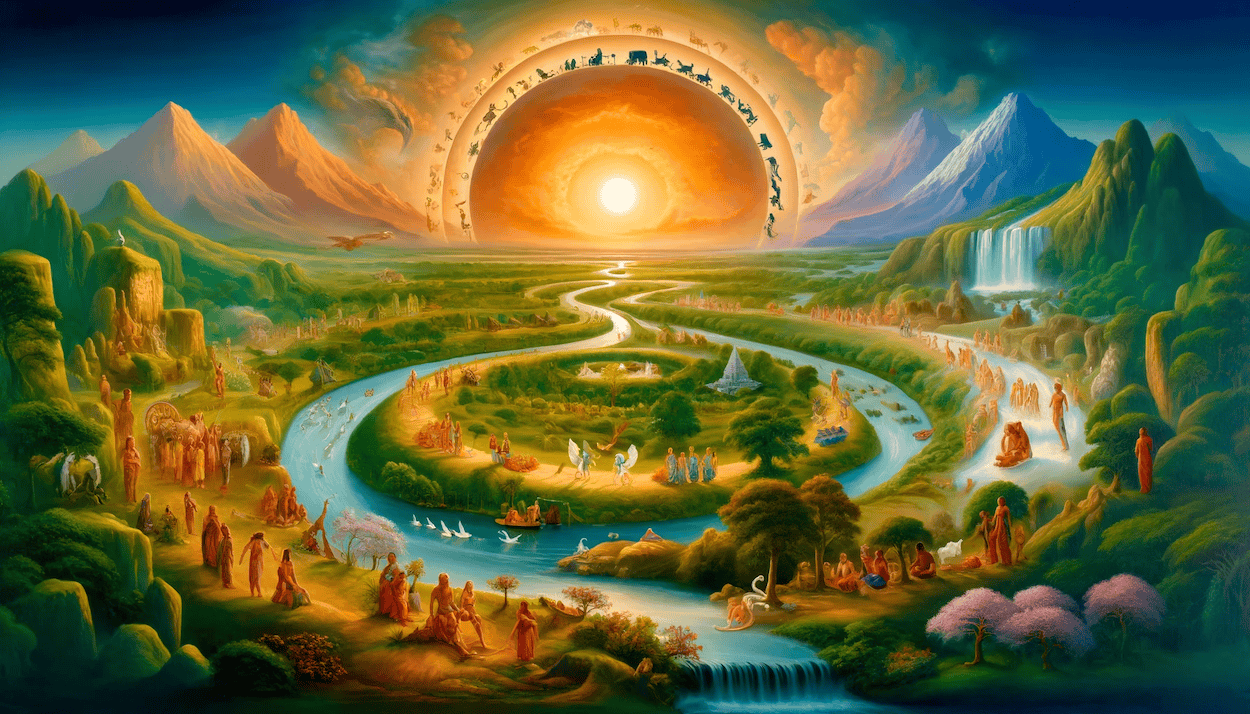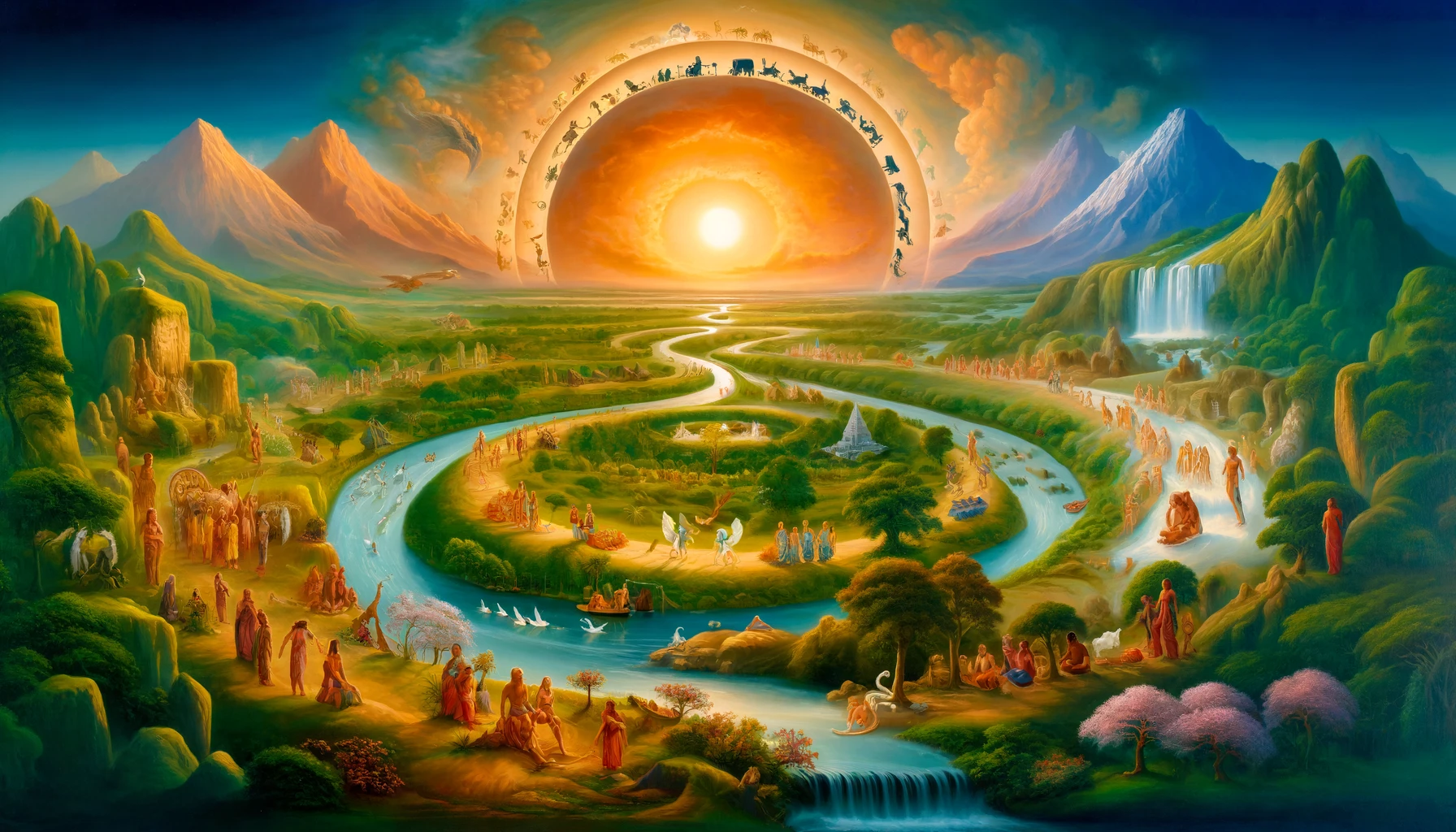 What Is Thought And How Does It Connect To Reincarnation?
What Is Thought And How Does It Connect To Reincarnation?
Thought is an automatic, self-generating emanation from an outdated, flesh-based tool (brain-mind-consciousness as contrived separate from Brahman – the Ultimate One Eternal Reality).
Thought is unnecessary for our success, safety, pleasure, peacefulness, intimacy, engagement, and illumination. It takes us beneath our potential and sedates our illumination.
Thought arises with or without provocation, and triggers the fleshy tool’s creation of additional thoughts, feelings, emotions, and projections, which often trigger more thought, more emotions, myriad reactions, and further, conjurings, fantasies, and emotional and psychological bindings.
If we cannot control our attachment to arising thoughts, they will continually infirm us and immerse our souls in a dualistic reality. This will cause the continual mental inflammation and the accumulation of our 12 unique types of karma, which eventually create and comprise the contrivance enveloping the soul and its impulse to continue the life, death, birth and rebirth (reincarnation) cycle.
Brain, Mind, Consciousness
Our exploration of the brain, mind, and consciousness transcends mere anatomical or psychological understanding; it leads us to a deeper realization about the nature of reality, our spiritual needs, and our true self.
Brain
The brain, a remarkable biological structure within our skulls, beneath a thin epidermis, serves as a necessary tool in the functioning of our bodies. It processes sensory information and supports cognitive functions like thinking and memory, enabling our interaction with the physical world.
Mind
Looking beyond this physical tool, we arrive at the mind, which serves as a broader canvas where thoughts, emotions, perceptions, and memories intermingle in the sustaining of the small individual self (Jiva). The mind, while appearing to be a product of the brain, is actually an arena where the play of dreams, desires, and projections unfold. The mind is not confined by the physicality of the brain; rather, it is where Jiva experiences life’s drama, ideas, and conjurings through various states and activities.
Consciousness
Beyond the mind lies the realm of pure consciousness, or pure awareness, which lives in every particle and boson in all of Creation throughout spacetime.
Consciousness is considered the fundamental essence of existence. It is not merely an attribute of the mind but is the very basis of all that is perceived and experienced. It envelopes and includes EVERYTHING.
This Consciousness is identical to Brahman, the Ultimate One Eternal Reality, which is unchanging, infinite, and omnipresent. It transcends the limitations imposed by the brain, body, mind, and physical world.
Our brain-mind-consciousness journeys ultimately invite us to realize our pure and eternal nature.
Truly, our individual existence (thoughts, feelings, projections, desires, dreams) – is merely a play of Maya (illusion), a manifestation of the deeper, unchanging reality that is Brahman experiencing Herself.
Understanding this helps us see beyond the ephemeral nature of our experiences to the eternal presence that underlies and unites all existence and ALL BEINGS THROUGHOUT SPACETIME.
This is what it means to be alive. Life is not just about navigating the physical, mental, and emotional challenges, but about awakening to the truth that we are not merely isolated Beings limited by our minds and bodies – and all the related desires, impulses, reactions, and projections.
We are expressions of a vast, divine consciousness that pervades everything.
If we can realize this concept, even for a moment, it can both enlighten and enchant us, inviting us to experience life with a profound sense of unity and wonder, recognizing the divine, living, expressive interplay woven deep into the fabric of our existence – including all we have been throughout myriad lives and all we imagine ourselves to be.
The 12 Types Of Karma
Karma is not just a scoreboard or tracker of deeds – but a profound architect of our soul’s destiny, influencing and provoking the cycle of reincarnation, amid the circus of events that reappear life after life after life. This cycle, driven by the accumulated actions of past and present lives, serves as both a binding chain and a transformative journey toward our awakening – liberation – Moksha.
Each of the 12 types of karma has a unique role and impact, and orchestrates the ongoing processes surrounding our reincarnations, compelling the soul to return, time and again, to the Earthly plane or a similar realm to burn away what barely exists.
These types of karma reveal the depths of how our actions resonate beyond the immediate, and how they create future experiences and shape our continual quest for self-realization – and finally, our liberation from the cycle of birth and death.
Sanchita Karma: A vast collection of accumulated deeds, thoughts, and actions from past lifetimes, waiting to be learned from and resolved.
Prarabdha Karma: The portion of accumulated karma that is due to be experienced in this lifetime, dictating major life circumstances like health and family.
Kriyamana Karma: Fresh karma generated by everyday actions and decisions, shaping immediate future outcomes.
Agami Karma: Actions taken today that will yield results in future lives, emphasizing the continuity of the soul’s journey.
Nitya Karma: Daily rituals and duties performed out of discipline and devotion, without desire for personal gain.
Naimittika Karma: Duties that arise from specific events or needs, calling for action beyond personal boundaries.
Kamya Karma: Actions performed with specific desires in mind, aimed at fulfilling personal ambitions ethically.
Prayaschitta Karma: Actions taken to atone for past misdeeds, aimed at cleansing and redemption.
Aprarabdha Karma: Dormant karma that has not yet influenced our lives but may activate under certain conditions.
Adhidaivika Karma: Involves larger forces like natural events or divine interventions that are beyond personal control.
Adhibhautika Karma: Results from interactions with other beings and the environment, stressing the importance of respectful and conscious living.
Adhyatmika Karma: Stemming from one’s own physical and mental actions, focusing on self-care and inner harmony.
Om Purnamadah Purnamidam, Purnat Purnam Udachyate
Purnasya Purnamadaya, Purnameva Vashishyate
Om Shanti Shanti Shanti
Translates roughly to: Taking away from the whole, the whole remains.
Going Deeper
Advaita Vedanta teaches that the ultimate reality is non-dual (Advaita)l, meaning there is no fundamental distinction between the individual and The Universe – the part and the whole. Everything is essentially one and the same reality, known as Brahman, which is pure consciousness.
There are several levels of reality: Paramārthika (ultimate reality), Vyavahārika (empirical or practical reality), and Pratibhāsika (illusory reality).
The brain and the mind are considered part of Vyavahārika, the empirical reality where dualistic distinctions (such as between the brain, mind, and consciousness) exist and are functional.
However, in the ultimate reality (Paramārthika), such distinctions dissolve into the non-dual consciousness – The One Eternal Universal Consciousness.
In Advaita Vedanta, the mind (Manas) along with intellect (Buddhi), ego (Ahamkara), and memory (Chitta) – collectively known as the Antahkarana (inner instrument) – are seen as tools through which the self (Atman) interacts with the empirical world. These are considered manifestations of Maya, the cosmic illusion, which makes the empirical world appear as real.
As we absorb, believe, and engage the dualistic reality that we contrived, we mostly create karma, thereby continuing to believe ourselves as separate from The All That Is – Brahman – The One Eternal Universal Consciousness.
Jiva vs Atman
In the philosophical teachings of Advaita Vedanta, the concepts of Jiva and Atman are central but distinctly different, each playing a unique role in understanding the nature of self and reality.
Jiva refers to the individual soul or self that is identified with the body, mind, and senses. It is the embodied state of consciousness that experiences the dualities of life, such as pleasure and pain, and is subject to the laws of karma and the cycle of birth and death.
Jiva is essentially the personal self, which perceives itself as separate and distinct from other beings and the universe. Jiva forms and worships the personality, amid myriad positions, titles, and projections, all of which give it confidence in its illusory construct and related activities.
Atman, on the other hand, is the universal self or soul. It is the eternal, changeless reality that is identical with Brahma. Atman is the pure, undivided consciousness that transcends individual existence and is inherent in all Beings. It is not affected by the physical changes or the flow of life’s experiences; it is beyond birth, death, and karma.
Jiva identifies with the body and mind and perceives itself as separate from the universal spirit or consciousness. In contrast, Atman represents the true essence that is eternal, indivisible, and inherently immersed with the absolute reality, Brahman.
Jiva is bound by ignorance and the illusion of separateness (Maya), leading to suffering, extenuating circumstances creating karma, and the cycle of reincarnation. Atman is inherently free and unbound, always existing in a state of pure Being, Consciousness, and bliss (Sat-Chit-Ananda).
In Advaita Vedanta, the ultimate goal of the spiritual journey is the realization that Jiva is not different from Atman. This realization, known as self-realization or enlightenment, involves transcending the individual ego and experiential duality to recognize one’s true nature as Atman, which is non-dual and identical with Brahman.
Enlightenment & Liberation
Our Ultimate Goal (Or hidden desire)
Our ultimate goal is Moksha (liberation), which is achieved by realizing the true nature of the self (Atman) as non-different from Brahman (Eternal Self or Consciousness). This realization transcends the mind and its operations, leading to a state where the distinctions imposed by the brain, mind, and ego are seen as illusory.
How Atman and Karma engage together:
Atman as Pure Consciousness: The Atman is considered the true Self, which is pure consciousness, unchanging, and eternal. It is identical to Brahman, the ultimate reality, implying that individual souls are not different from the universal consciousness.
Karma and the Illusion of Individuality: While the Ātman is beyond birth and death, the apparent (contrived) individual self (Jiva) experiences birth, life, and death due to ignorance (Avidya) of its true nature. This ignorance gives rise to ego (Ahamkara) and mind (Manas), which engage in actions (reactions, desires, projections, and more), thereby accumulating karma.
Impact of Karma on Reincarnation: The karma accumulated by the Jiva influences its cycle of birth and rebirth. Different types of karma (as outlined previously) determine the life circumstances and experiences of the jiva, pushing it through various lifetimes until the karma is resolved.
Liberation (Moksha): Moksha, or liberation, which is the realization of one’s true nature as the Atman, free from the cycles of birth and death. Achieving moksha means transcending karma (the 12 types outlined above), as one recognizes that the self (Atman) is beyond all action and unaffected by karma.
Role of Knowledge (Jnana): The realization of the Atman is identical to Brahman and achieved through knowledge (Jnana), particularly the knowledge that all dualities and distinctions (like those imposed by karma) are illusory.
This knowledge dissolves the ego and the false identification with the mind and body, freeing the soul from the shackles of karma.
Finally
While karma governs the cycle of births and experiences based on actions, the soul or Atman remains ever pure and untouched by these processes. The journey through karma is essentially a journey through illusion or Maya, with the ultimate realization being that the soul is beyond all dualities, including those created by karma.
In short, don’t get too excited about karma. Allow circumstances as they arise and your karma will dissolve accordingly. No engagement and no drama, therefore no bondage. Seek enlightened masters and absorb their embodiment of these teachings – and all will be well.
Release thoughts as they emerge and love from your pure self, and you will heal and expand in ways you have never imagined. Releasing thoughts eventually clears our karma and dissolves the dualistic reality we imagine, freeing us to break free from the cycle of reincarnation.
Enjoy The Shankara Oracle – the most intense, enjoyable, and illuminating tool to help you walk the path of Self-realization.




